5D Bend Pipe
The radius of a 5D pipe bend is actually what is 5 times the nominal diameter.
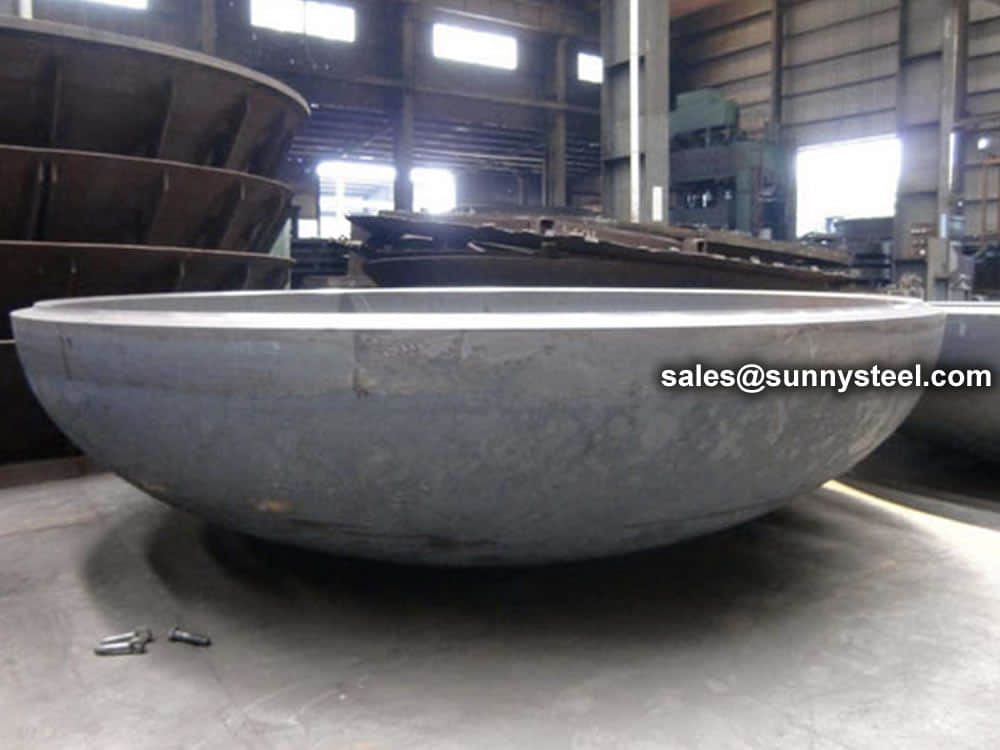
Vessel heads are very varied used in candle holders to pipe end-pieces or pressure vessels in equipment construction.
Vessels used to store liquids at low pressure are normally fitted with flat end sections. This is the cheapest way of enclosing the end of a vessel. For storage of fluids at higher pressures, the ends are normally domed to reduce mechanical stresses.
For pressures over 10 bar, ellipsoidal heads are often used. In cross-section, the head resembles an ellipse, its radius varying continuously. This results in a smooth transition between the dome and the cylindrical part of the vessel. Ellipsodial heads are deeper than comparable torispherical heads.
Compared with elliptical head, due to its easier manufacturing processes, the torispherical head is often used in addition to the pressure is larger diameter pressure vessel.
With the same same design conditions with the same design pressure, design temperature and material, your calculated wall thickness under internal pressure will be approximately half of the shell thickness.
For example, if you have calculated your shell thickness under internal pressure and obtained 12 mm, your hemispherical head thickness also will be approximately 6 mm.
The inside depth of your Torispherical head will be one-half of head inside diameter (h = D/2).
You need to make a dimensional inspection on the pressure Torispherical head for any effort for the fit-up process. The dimensional inspection is done on the knuckle radius, crown radius, skirt length, depth and thickness.
We are manufacturer of End caps 48inch api 5l x46 carbon steel din28011 and supply high quality End caps 48inch api 5l x46 carbon steel din28011 in both large and small quantities worldwide and offer you the best prices in the market.
Pipeline steel plate API 5L PSL1 X46 and Pipeline steel coil API 5L PSL1 X46 are mainly used in making steel pipes for pipeline which transporting oil and gas.
Technical Requirements & Additional Services:
As we know line pipe or casing and tubing have two different manufacturing types, seamless and welded. So pipeline steel plate is used to make welded line pipe, including ERW, LSAW, SSAW welding processes. Further more, casing and tubing in API 5CT standard could also be made in welded ERW type, so pipeline steel plate and coils also covers these pipes. (But in most cases, casing and tubing are required in seamless types.)
SunnySteel supplies pipeline steel plate (steel coil) in API 5L and API 5CT. Applied for manufacturing line pipes, casing and tubing.
Carbon steel caps manufactured using superior grade raw materials. Carbon steel caps are used for connecting pipes of different diameters and find wide applications in various chemicals, construction industries, paper, cement & ship builders.
A head is one of the end caps on a cylindrical pressure vessel.
The different types of formed heads are Smooth formed head. Torispherical head. Semi-elliptical dished head.
Tank heads are the end caps on cylindrical pressure vessels. They generally conform to ASME or similar standards due to the high pressures they must withstand for use on gas storage tanks, power cylinders, distillation towers and reactors.
Pressure vessel heads, hemispheres and other spherical structures, cones and convex discs.
Freedom of design allows us to optimise sizes and produce the shapes required for each individual application to customer specification. The largest components are supplied as dimensionally accurate, ready-to-install components for the customer to weld together. The smallest pressure vessel head diameter we can manufacture is 1,000mm. The diameter of the largest pressure vessel head we have supplied as a ready-to-install component is 46,800 mm. The diameter of the largest pressure vessel head we have supplied in one piece was 10,800 mm.
All vessel heads are manufactured by cold forming. The steel grades available are carbon, austenitic, duplex and nickel steels.
Our production facilities are equipped to produce a wide range of sizes and thicknesses to suit the required product. Depending on the type of material, of course.

Pressure vessel heads are an integral part of the pressure vessels used in oil and gas processing facilities — specifically, the vessels designed to contain and handle high-pressure gases, liquids, and hydrocarbons. The structural integrity of these heads ensures pressure containment and facilitates the safe operation of the vessels.
Various products in the oil and gas industry are stored in storage tanks, including crude oil, refined petroleum products, natural gas liquids (NGLs), and liquefied natural gas (LNG). The heads ensure the structural integrity of the tanks, prevent leakage, and maintain pressure stability.
Phase separation in oil and gas production requires pressure vessel heads at work in separators. These separators are critical for separating oil, gas, and water during production, so they’re a standard component. The heads help maintain the pressure differentials required for efficient separation and optimise the overall performance of the separators.
Pressure vessel heads are utilised in heat exchangers commonly employed in oil and gas processing plants. The exchangers facilitate heat transfer between different process streams, such as heating or cooling of fluids. As the heads ensure pressure containment, efficient heat exchange is possible.
Pressure vessel heads are integral to distillation columns for refining crude oil into various fractions and petrochemicals. The heads provide structural support, maintain pressure differentials, and ensure the separation and fractionation processes occur efficiently.
The reactors that facilitate chemical reactions, like those used for hydrocarbon cracking or polymerisation, rely on pressure vessel heads to operate effectively. The heads help maintain the required pressure and contain the reaction environment, ensuring safe and controlled operation.
During the distillation process of crude oil and natural gas liquids, pressure vessel heads work in the fractionation towers. These towers facilitate the separation of various components based on their boiling points, with the heads ensuring pressure integrity and assisting in efficient fractionation processes.
Pressure vessel heads are used in flare knockout drums, which remove any liquid droplets from gases before they are safely released through a flare system. The heads assist in pressure containment and separation of liquids from gases, preventing the entry of fluids into the flare system.

Pipe caps fit over or are welded onto the end of a pipe, providing a liquid or gas tight seal.
End Caps are used for connecting pipes of different diameters and find wide applications in various chemicals, construction industries, paper, cement & ship builders.
Pipe caps are widely well-known for the utmost output and outstanding results that it gives.
It is commonly made from the one steel plate, so it should be seamless. The pipe end caps are available in various shapes, like the hemispherical, oval, round etc.
Before purchasing pipe caps in bulk, the buyer should take into account a number of crucial criteria. The following crucial requirements must be taken into account:
This characteristic is appropriate for caps with a round form when the item that has to be protected has a male NPT thread.
This size choice is only appropriate for caps with a round form and a male BSP thread on the item to be capped.
Only round caps and plugs may be made with this crucial size. The primary thread diameter is the most crucial factor to take into account when fittings have straight threads. However, when a cap, plug, or item to be capped has a tapered (NPT or BSP) thread, its size is not a crucial factor to take into account.
The size and shape of pipe caps are other crucial factors to take into account. distinct pipe caps have distinct features. Features include:
Round Caps: The flange, slotted head, knurled or faceted head, retaining head, and tear tab are all common characteristics of round caps. A flange is designed to make it simple to remove pipes or tubes or to provide additional protection. Additionally, flanges aid in preventing inadvertent plug ejection through the aperture. A screwdriver makes it simple to put on or take off slotted caps. Typically, only threaded caps and plugs are intended to be used with knurled or faceted heads. Installation and removal are hassle-free using facets or knurls. It is simple to remove pipe caps that have a tear-tab or strip supplied.
Square or Rectangular Cap: When choosing a square or rectangular cap, the length and breadth should be taken into account the most. For square caps, the length and breadth are the same dimension, but the width is the smaller cross sectional measurement for rectangular caps.
ASME B16.9 Standard covers overall dimensions, tolerances,ratings, testing, and markings for factory-made wrought buttwelding fittings in sizes NPS 1⁄2 through NPS 48 (DN 15 through DN 1200).
Download PDF| Nominal | Outside Diameter | 90° Elbows | 45° Elbows | 180° Returns | ||||
|---|---|---|---|---|---|---|---|---|
| Pipe Size |
Long Radius | Short Radius | Long Radius | Long Radius | ||||
| (inches) | (mm) | (inches) | Center to Face | Center to Face | Center to Face | Radius | Center to Center | Back to face |
| (inches) | (inches) | (inches) | (inches) | (inches) | (inches) | |||
| 1/2 | 21.3 | 0.84 | 1.5 | – | 5/8 | 2 | 1.875 | |
| 3/4 | 26.7 | 1.05 | 1.125 | – | 7/16 | 2.25 | 1.6875 | |
| 1 | 33.4 | 1.315 | 1.5 | 1 | 7/8 | 3 | 2.1875 | |
| 1.25 | 42.2 | 1.66 | 1.875 | 1.25 | 1 | 3.75 | 2.75 | |
| 1.5 | 48.3 | 1.9 | 2.25 | 1.5 | 1.125 | 3 | 4.5 | 3.25 |
| 2 | 60.3 | 2.375 | 3 | 2 | 1.375 | 4 | 6 | 4.1875 |
| 2.5 | 73 | 2.875 | 3.75 | 2.5 | 1.75 | 5 | 7.5 | 5.1875 |
| 3 | 88.9 | 3.5 | 4.5 | 3 | 2 | 6 | 9 | 6.25 |
| 3.5 | 101.6 | 4 | 5.25 | 3.5 | 2.25 | 7 | 10.5 | 7.25 |
| 4 | 114.3 | 4.5 | 6 | 4 | 2.5 | 8 | 12 | 8.25 |
| 5 | 141.3 | 5.563 | 7.5 | 5 | 3.125 | 10 | 15 | 10.3125 |
| 6 | 168.3 | 6.625 | 9 | 6 | 3.75 | 12 | 18 | 12.3125 |
| 8 | 219.1 | 8.625 | 12 | 8 | 5 | 12 | 24 | 16.3125 |
| 10 | 273.1 | 10.75 | 15 | 10 | 6.25 | 15 | 30 | 20.375 |
| 12 | 323.9 | 12.75 | 18 | 12 | 7.5 | 18 | 36 | 24.375 |
| NOMINAL PIPE SIZE NPS | ANGULARITY TOLERANCES | ANGULARITY TOLERANCES |
|---|---|---|
| Size | Off Angle Q | Off Plane P |
| ½ to 4 | 0.03 | 0.06 |
| 5 to 8 | 0.06 | 0.12 |
| 10 to 12 | 0.09 | 0.19 |
| 14 to 16 | 0.09 | 0.25 |
| 18 to 24 | 0.12 | 0.38 |
| 26 to 30 | 0.19 | 0.38 |
| 32 to 42 | 0.19 | 0.5 |
| 44 to 48 | 0.18 | 0.75 |
All dimensions are given in inches. Tolerances are equal plus and minus except as noted.
The ASME B16.9 pipe fittings can be used under the jurisdiction of the ASME Boiler & Pressure Vessel Code (BPVC) as well as the ASME Code for pressure piping. Referencing pressure ratings of flanges per ASME B16.5, they can be designated as Classes 150, 300, 600, 900, 1500 and 2500. The allowable pressure ratings for ASME B16.9 pipe fittings may be calculated as for straight seamless pipe of equivalent material in accordance with the rules established in the applicable sections of ASME B31 Code for pressure piping.
The design of butt welding pipe fittings made to ASME B16.9 shall be established by one of the following methods: (a) mathematical analyses contained in pressure vessel or piping codes; (b) proof testing; (c) experimental stress analysis with hydrostatic testing to validate experimental results; (d) detailed stress analysis with results evaluation.
Generally, ASME B16.9 pipe fittings shall be marked to show the following details: “trademark + material grade + wall thickness + size + heat number”. For example, “M ASTM A234 WP5 SCH80 6″ 385“. When steel stamps are used, care shall be taken so that
the marking is not deep enough or sharp enough to cause cracks or to reduce the wall thickness of the fitting below the minimum allowed.
The ASME B16.9 fittings may be made from an extensive range of mateirals covering (1) carbon and low-alloy steels in accordance with ASTM A234 and ASTM A420; (2) austenitic and duplex stainless steels in accordance with ASTM A403 and ASTM A815; (3) nickel alloys in accordance with ASTM B366; (4) aluminum alloys in accordance with ASTM B361; and (5) titanium alloys in accordance with ASTM B363.

Sizes 1/2″ – 48″
End cap is commonly made from the one steel plate, so it should be seamless. The pipe end caps are available in various shapes, like the hemispherical, oval, round etc.
| Out diameter | High size | Wall thickness accord to 'E' | ||
|---|---|---|---|---|
| DN | NPS | E | E1 | E |
| 15 | 1/2 | 25 | 25 | 3.73 |
| 20 | 3/4 | 25 | 25 | 3.91 |
| 25 | 1 | 38 | 38 | 4.55 |
| 32 | 1 1/4 | 38 | 38 | 4.85 |
| 40 | 1 1/2 | 38 | 38 | 5.08 |
| 50 | 2 | 38 | 44 | 5.54 |
| 65 | 2 1/2 | 38 | 51 | 7.01 |
| 80 | 3 | 51 | 64 | 7.62 |
| 90 | 3 1/2 | 64 | 76 | 8.08 |
| 100 | 4 | 64 | 76 | 8.56 |
| 125 | 5 | 76 | 89 | 9.53 |
| 150 | 6 | 89 | 102 | 10.97 |
| 200 | 8 | 102 | 127 | 12.7 |
| 250 | 10 | 127 | 152 | 12.7 |
| 300 | 12 | 152 | 178 | 12.7 |
| 350 | 14 | 165 | 191 | 12.7 |
| 400 | 16 | 178 | 203 | 12.7 |
| 450 | 18 | 203 | 229 | 12.7 |
| 500 | 20 | 229 | 254 | 12.7 |
| 550 | 22 | 254 | 254 | 12.7 |
| 600 | 24 | 267 | 305 | 12.7 |
| 650 | 26 | 267 | ||
| 700 | 28 | 267 | ||
| 750 | 30 | 267 | ||
| 800 | 32 | 267 | ||
| 850 | 34 | 267 | ||
| 900 | 36 | 267 | ||
| 950 | 38 | 305 | ||
| 1000 | 40 | 305 | ||
| 1050 | 42 | 305 | ||
| 1100 | 44 | 343 | ||
| 1150 | 46 | 343 | ||
| 1200 | 48 | 343 | ||
Size range: 1/2 to 56 inches (DN15 to DN1400)
Pressure: SCH5 to SCH160v
Wall Thickness:sch10, sch20, sch30, std, sch40, sch60, xs, sch80, sch100, sch120, sch140, sch160, xxs, sch5s, sch20s, sch40s, sch80s
Max. wall thickness: 200mm
| OD | ND | INCH | SCH20 | SCH40 | SCH80 | STD | XS |
|---|---|---|---|---|---|---|---|
| Weight | Weight | Weight | Weight | Weight | |||
| 88.9 | 80 | 3 | 0.66 | 0.92 | 0.66 | 0.92 | |
| 114.3 | 100 | 4 | 1.17 | 1.67 | 1.17 | 1.67 | |
| 141.3 | 125 | 5 | 1.91 | 2.78 | 1.91 | 2.78 | |
| 168.3 | 150 | 6 | 2.9 | 4.47 | 2.9 | 4.47 | |
| 219.1 | 200 | 8 | 4.09 | 5.19 | 8.05 | 5.19 | 8.05 |
| 273 | 250 | 10 | 6.36 | 9.15 | 12.5 | 9.15 | 12.5 |
| 323.8 | 300 | 12 | 9.08 | 14.4 | 26.8 | 13.2 | 17.3 |
| 355.6 | 350 | 14 | 13.2 | 18.8 | 34.5 | 15.9 | 20.4 |
| 406.4 | 400 | 16 | 16.8 | 26.7 | 47.7 | 20.4 | 26.3 |
| 457.2 | 450 | 18 | 24.8 | 41.8 | 67.7 | 25.9 | 33.6 |
| 508 | 500 | 20 | 32.2 | 54.9 | 91.3 | 32.2 | 42.7 |
| 558.8 | 550 | 22 | 37.7 | 49.9 | |||
| 609.6 | 600 | 24 | 46.3 | 93.1 | 155 | 46.3 | 59.5 |
Based on different materials, pipe caps include carbon steel cap, stainless steel cap, and alloy steel cap etc.
Depending on their construction, pipe caps contain threaded cap, tapered cap and anti-roll cap etc.

| Outside diameter mm |
Wall thickness mm |
Height mm |
Weight kg |
|---|---|---|---|
| D | s1 | ||
| 21,3 | 2,0 | 25,0 | 0,060 |
| 26,9 | 2,3 | 32,0 | 0,070 |
| 33,7 | 2,6 | 38,0 | 0,110 |
| 3,2 | 0,130 | ||
| 42,4 | 2,6 | 38,0 | 0,130 |
| 3,6 | 0,170 | ||
| 48,3 | 2,6 | 38,0 | 0,200 |
| 4,0 | 0,230 | ||
| 60,3 | 2,9 | 38,0 | 0,280 |
| 4,5 | 0,320 | ||
| 76,1 | 2,9 | 38,0 | 0,340 |
| 5,0 | 0,390 | ||
| 88,9 | 3,2 | 51,0 | 0,530 |
| 5,6 | 0,700 | ||
| 108,0 | 3,6 | 64,0 | 1,000 |
| 114,3 | 3,6 | 64,0 | 1,000 |
| 6,3 | 1,500 | ||
| 133,0 | 4,0 | 76,0 | 1,600 |
| 139,7 | 4,0 | 76,0 | 1,700 |
| 6,3 | 2,500 | ||
| 159,0 | 4,5 | 90,0 | 2,400 |
| 168,3 | 4,5 | 89,0 | 2,650 |
| 7,1 | 3,550 | ||
| 219,0 | 6,3 | 100,0 | 5,550 |
| 8,0 | 6,700 | ||
| 273,0 | 6,3 | 127,0 | 8,800 |
| 323,9 | 7,1 | 152,0 | 14,000 |
| 355,6 | 8,0 | 165,0 | 16,500 |
| 406,4 | 8,8 | 178,0 | 18,200 |
| 508,0 | 11,0 | 229,0 | 38,000 |

ISO - dimensions
| dimensions d1 x s | height L | weight / kg |
|---|---|---|
| 21,3 x 2,0 | 9,0 | 0,01 |
| 26,9 x 2,0 | 9,0 | 0,01 |
| 33,7 x 2,0 | 13,0 | 0,02 |
| 42,4 x 2,0 | 13,0 | 0,04 |
| 48,3 x 2,0 | 13,5 | 0,05 |
| 60,3 x 2,0 | 18,5 | 0,07 |
| 76,1 x 2,0 | 20,5 | 0,10 |
| 88,9 x 2,0 | 25,0 | 0,15 |
| 114,3 x 2,0 | 28,0 | 0,26 |
| 114,3 x 3,0 | 29,0 | 0,39 |
| 139,7 x 3,0 | 38,5 | 0,60 |
| 168,3 x 3,0 | 47,5 | 0,90 |
| 219,1 x 3,0 | 63,5 | 1,32 |
| 273,0 x 3,0 | 93,0 | 1,95 |
| 323,9 x 3,0 | 102,0 | 2,70 |
| 355,6 x 3,0 | 109,0 | 3,80 |
| 406,4 x 3,0 | 123,0 | 5,00 |
| 457,2 x 3,0 | 123,0 | 6,10 |
| 508,0 x 3,0 | 133,0 | 7,60 |
| dimensions d1 x s | height L | weight / kg |
|---|---|---|
| 20,0 x 2,0 | 9,0 | 0,02 |
| 25,0 x 2,0 | 9,0 | 0,03 |
| 30,0 x 2,0 | 13,5 | 0,03 |
| 35,0 x 2,0 | 13,5 | 0,04 |
| 44,0 x 2,0 | 15,0 | 0,04 |
| 54,0 x 2,0 | 15,0 | 0,05 |
| 70,0 x 2,0 | 19,5 | 0,07 |
| 84,0 x 2,0 | 24,0 | 0,15 |
| 104,0 x 2,0 | 28,0 | 0,20 |
| 129,0 x 2,0 | 37,0 | 0,36 |
| 154,0 x 2,0 | 43,0 | 0,50 |
| 156,0 x 3,0 | 44,0 | 0,94 |
| 204,0 x 2,0 | 62,0 | 0,80 |
| 206,0 x 3,0 | 63,0 | 1,20 |
| 254,0 x 2,0 | 72,0 | 1,30 |
| 256,0 x 3,0 | 73,0 | 1,95 |
| 306,0 x 3,0 | 83,0 | 2,50 |
| Out diameter | High size | Wall thickness accord to 'E' | ||
|---|---|---|---|---|
| DN | NPS | E | E1 | E |
| 15 | 1/2 | 25 | 25 | 3.73 |
| 20 | 3/4 | 25 | 25 | 3.91 |
| 25 | 1 | 38 | 38 | 4.55 |
| 32 | 1 1/4 | 38 | 38 | 4.85 |
| 40 | 1 1/2 | 38 | 38 | 5.08 |
| 50 | 2 | 38 | 44 | 5.54 |
| 65 | 2 1/2 | 38 | 51 | 7.01 |
| 80 | 3 | 51 | 64 | 7.62 |
| 90 | 3 1/2 | 64 | 76 | 8.08 |
| 100 | 4 | 64 | 76 | 8.56 |
| 125 | 5 | 76 | 89 | 9.53 |
| 150 | 6 | 89 | 102 | 10.97 |
| 200 | 8 | 102 | 127 | 12.7 |
| 250 | 10 | 127 | 152 | 12.7 |
| 300 | 12 | 152 | 178 | 12.7 |
| 350 | 14 | 165 | 191 | 12.7 |
| 400 | 16 | 178 | 203 | 12.7 |
| 450 | 18 | 203 | 229 | 12.7 |
| 500 | 20 | 229 | 254 | 12.7 |
| 550 | 22 | 254 | 254 | 12.7 |
| 600 | 24 | 267 | 305 | 12.7 |
| 650 | 26 | 267 | ||
| 700 | 28 | 267 | ||
| 750 | 30 | 267 | ||
| 800 | 32 | 267 | ||
| 850 | 34 | 267 | ||
| 900 | 36 | 267 | ||
| 950 | 38 | 305 | ||
| 1000 | 40 | 305 | ||
| 1050 | 42 | 305 | ||
| 1100 | 44 | 343 | ||
| 1150 | 46 | 343 | ||
| 1200 | 48 | 343 | ||
| D(inch) | DN | OD | SCH5s | SCH10s | SCH10 | SCH20 | SCH30 | SCH40s | STD | SCH40 |
|---|---|---|---|---|---|---|---|---|---|---|
| 1/8" | 6 | 10.3 | - | 1.24 | 1.73 | 1.73 | 1.73 | |||
| 1/4" | 8 | 13.7 | - | 1.65 | - | - | - | 2.24 | 2.24 | 2.24 |
| 3/8" | 10 | 17.1 | - | 1.65 | - | - | - | 2.31 | 2.31 | 2.31 |
| 1/2" | 15 | 21.3 | 1.65 | 2.11 | - | - | - | 2.77 | 2.77 | 2.77 |
| 3/4" | 20 | 26.7 | 1.65 | 2.11 | - | - | - | 2.87 | 2.87 | 2.87 |
| 1" | 25 | 33.4 | 1.65 | 2.77 | - | - | - | 3.38 | 3.38 | 3.38 |
| 11/4" | 32 | 42.2 | 1.65 | 2.77 | - | - | - | 3.56 | 3.56 | 3.56 |
| 11/2" | 40 | 48.3 | 1.65 | 2.77 | - | - | - | 3.68 | 3.68 | 3.68 |
| 2" | 50 | 60.3 | 1.65 | 2.77 | - | - | - | 3.91 | 3.91 | 3.91 |
| 21/2" | 65 | 73 | 2.11 | 3.05 | - | - | - | 5.16 | 5.16 | 5.16 |
| 3" | 80 | 88.9 | 2.11 | 3.05 | - | - | - | 5.49 | 5.49 | 5.49 |
| 31/2" | 90 | 101.6 | 2.11 | 3.05 | - | - | - | 5.74 | 5.74 | 5.74 |
| 4" | 100 | 114.3 | 2.11 | 3.05 | - | - | - | 6.02 | 6.02 | 6.02 |
| 5" | 125 | 141.3 | 2.77 | 3.4 | - | - | - | 6.55 | 6.55 | 6.55 |
| 6" | 150 | 168.3 | 2.77 | 3.4 | - | - | - | 7.11 | 7.11 | 7.11 |
| 8" | 200 | 219.1 | 2.77 | 3.76 | - | 6.35 | 7.04 | 8.18 | 8.18 | 8.18 |
| 10" | 250 | 273.1 | 3.4 | 4.19 | - | 6.35 | 7.8 | 9.27 | 9.27 | 9.27 |
| 12" | 300 | 323.9 | 3.96 | 4.57 | - | 6.35 | 8.83 | 9.53 | 9.53 | 10.31 |
| 14" | 350 | 355.6 | 3.96 | 4.78 | 6.35 | 7.92 | 9.53 | - | 9.53 | 11.13 |
| 16" | 400 | 406.4 | 4.19 | 4.78 | 6.35 | 7.92 | 9.53 | - | 9.53 | 12.7 |
| 18" | 450 | 457.2 | 4.19 | 4.78 | 6.35 | 7.92 | 11.13 | - | 9.53 | 14.27 |
| 20" | 500 | 508 | 4.78 | 5.54 | 6.35 | 9.53 | 12.7 | - | 9.53 | 15.09 |
| 22" | 550 | 558.8 | 4.78 | 5.54 | 6.35 | 9.53 | 12.7 | - | 9.53 | |
| 24" | 600 | 609.6 | 5.54 | 6.35 | 6.35 | 9.53 | 14.27 | - | 9.53 | 17.48 |
| 26" | 650 | 660.4 | - | - | 7.92 | 12.7 | - | - | 9.53 | - |
| 28" | 700 | 711.2 | - | - | 7.92 | 12.7 | 15.88 | - | 9.53 | - |
| 30" | 750 | 762 | 6.35 | 7.92 | 7.92 | 12.7 | 15.88 | - | 9.53 | - |
| 32" | 800 | 812.8 | - | - | 7.92 | 12.7 | 15.88 | - | 9.53 | 17.48 |
| 34" | 850 | 863.6 | - | - | 7.92 | 12.7 | 15.88 | - | 9.53 | 17.48 |
| 36" | 900 | 914.4 | - | - | 7.92 | 12.7 | 15.88 | - | 9.53 | 19.05 |
| 38" | 950 | 965.2 | - | - | - | - | - | - | 9.53 | - |
| 40" | 1000 | 1016 | - | - | - | - | - | - | 9.53 | - |
| 42" | 1050 | 1066.8 | - | - | - | - | - | - | 9.53 | - |
| 44" | 1100 | 1117.6 | - | - | - | - | - | - | 9.53 | - |
| 46" | 1150 | 1168.4 | - | - | - | - | - | - | 9.53 | - |
| 48" | 1200 | 1219.2 | - | - | - | - | - | - | 9.53 | - |
Pipe fitting dimensions are in either metric or Standard English.
Because pipe fitting covers Pipe Fitting Dimensions several aspects, only the most common pipe fitting sizes can be given here. The most applied version is the 90° long radius and the 45° elbow, while the 90° short radius elbow is applied if there is too little space. The function of a 180° elbow is to change direction of flow through 180°. Both, the LR and the SR types have a center to center dimension double the matching 90° elbows. These fittings will generally be used in furnesses or other heating or cooling units.
Some of the standards that apply to buttwelded fittings are listed below. Many organizations such as ASME, ASTM, ISO, MSS, etc. have very well developed standards and specifications for buttwelded fittings. It is always up to the designer to ensure that they are following the applicable standard and company specification, if available, during the design process.
Some widely used pipe fitting standards are as follows:
This is one of the reputed organizations in the world developing codes and standards.
The schedule number for pipe fitting starts from ASME/ANSI B16. The various classifications of ASME/ANSI B16 standards for different pipe fittings are as follows:
This is one of the largest voluntary standards development organizations in the world. It was originally known as the American Society for Testing and Materials (ASTM).
AWWA About – Established in 1881, the American Water Works Association is the largest nonprofit, scientific and educational association dedicated to managing and treating water, the world’s most important resource.
ANSI is a private, non-profit organization. Its main function is to administer and coordinate the U.S. voluntary standardization and conformity assessment system. It provides a forum for development of American national standards. ANSI assigns “schedule numbers”. These numbers classify wall thicknesses for different pressure uses.
The Manufacturers Standardization Society (MSS) of the Valve and Fittings Industry is a non-profit technical association organized for development and improvement of industry, national and international codes and standards for: Valves, Valve Actuators, Valve Modification, Pipe Fittings, Pipe Hangers, Pipe Supports, Flanges and Associated Seals
Piping codes imply the requirements of design, fabrication, use of materials, tests and inspection of various pipe and piping system. It has a limited jurisdiction defined by the code. On the other hand, piping standards imply application design and construction rules and requirements for pipe fittings like adapters, flanges, sleeves, elbows, union, tees, valves etc. Like a code, it also has a limited scope defined by the standard.
“Standards” on pipe fittings are based on certain factors like as follows:
BSP is the U.K. standard for pipe fittings. This refers to a family of standard screw thread types for interconnecting and sealing pipe ends by mating an external (male) with an internal (female) thread. This has been adopted internationally. It is also known as British Standard Pipe Taper threads (BSPT )or British Standard Pipe Parallel (Straight) threads (BSPP ). While the BSPT achieves pressure tight joints by the threads alone, the BSPP requires a sealing ring.
This is the Japanese industrial standards or the standards used for industrial activities in Japan for pipe, tube and fittings and published through Japanese Standards Associations.
National Pipe Thread is a U.S. standard straight (NPS) threads or for tapered (NPT) threads. This is the most popular US standard for pipe fittings. NPT fittings are based on the internal diameter (ID) of the pipe fitting.
We are manufacturer of Flange bolts & Nuts and supply high quality
The AN standard was originally designed for the U.S. Military. Whenever, a pipe fitting is AN fittings, it means that the fittings are measured on the outside diameter of the fittings, that is, in 1/16 inch increments.
For example, an AN 4 fitting means a fitting with an external diameter of approximately 4/16″ or ¼”. It is to be noted that approximation is important because AN external diameter is not a direct fit with an equivalent NPT thread.
Dash size is the standard used to refer to the inside diameter of a hose. This indicates the size by a two digit number which represents the relative ID in sixteenths of an inch. This is also used interchangeably with AN fittings. For example, a Dash “8” fitting means an AN 8 fitting.
ISO is the industrial pipe, tube and fittings standards and specifications from the International Organization for Standardization. ISO standards are numbered. They have format as follows:
“ISO[/IEC] [IS] nnnnn[:yyyy] Title” where
| Standard | Specification |
|---|---|
| ASTM A234 | Standard Specification for Piping Fittings of Wrought Carbon Steel and Alloy Steel for Moderate and High Temperature Service |
| ASTM A420 | Standard Specification for Piping Fittings of Wrought Carbon Steel and Alloy Steel for Low-Temperature Service |
| ASTM A234 WPB | ASTM A234 WPB refers to a specific grade of carbon steel pipe fittings, which are widely used in pressure piping and pressure vessel fabrication for service at moderate and elevated temperatures. |
| ASME B16.9 | ASME B16.9 Standard covers overall dimensions, tolerances,ratings, testing, and markings for factory-made wrought buttwelding fittings in sizes NPS 1⁄2 through NPS 48 (DN 15 through DN 1200). |
| ASME B16.28 | ASME B16.28 Standard covers ratings, overall dimensions, testing, tolerances, and markings for wrought carbon and alloy steel buttwelding short radius elbows and returns. |
| MSS SP-97 | MSS SP-97 Standard Practice covers essential dimensions, finish, tolerances, testing, marking, material, and minimum strength requirements for 90 degree integrally reinforced forged branch outlet fittings of buttwelding, socket welding, and threaded types. |
| ASTM A403 | Standard Specification for Wrought Austenitic Stainless Steel Piping Fittings. |
| DIN | EN | ASME |
|---|---|---|
| St 35.8 I St 35.8 III 15 Mo 3 13 CrMo 4 4 10 CrMo 9 10 St 35 N St 52.0 St 52.4 |
P235GH-TC1 P235GH-TC2 16Mo3 13CrMo4-5 10CrMo9-10 X10CrMoVNb9-1 P215NL P265NL L360NB L360NE P355N P355NL1 P355NH |
WPB WPL6 WPL3 WPHY 52 WP11 WP22 WP5 WP9 WP91 WP92 |
Visual Inspection is conducted on fittings to check any surface imperfections. Both fittings body and weld are checked for any visible surface imperfections such as dents, die marks, porosity, undercuts, etc. Acceptance as per applicable standard.
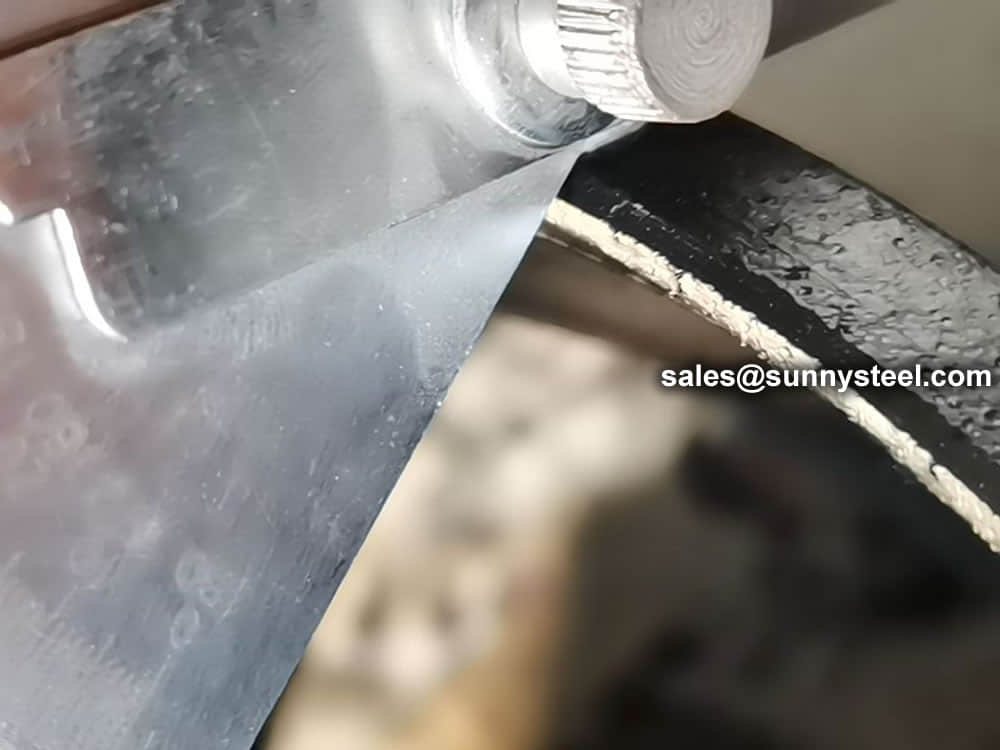
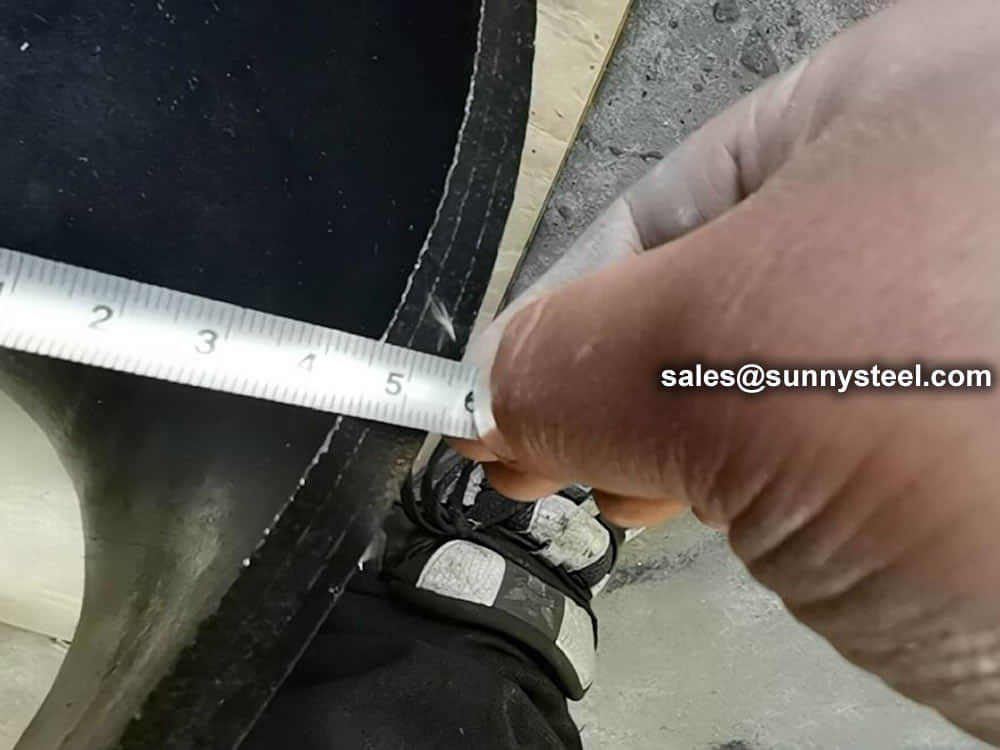
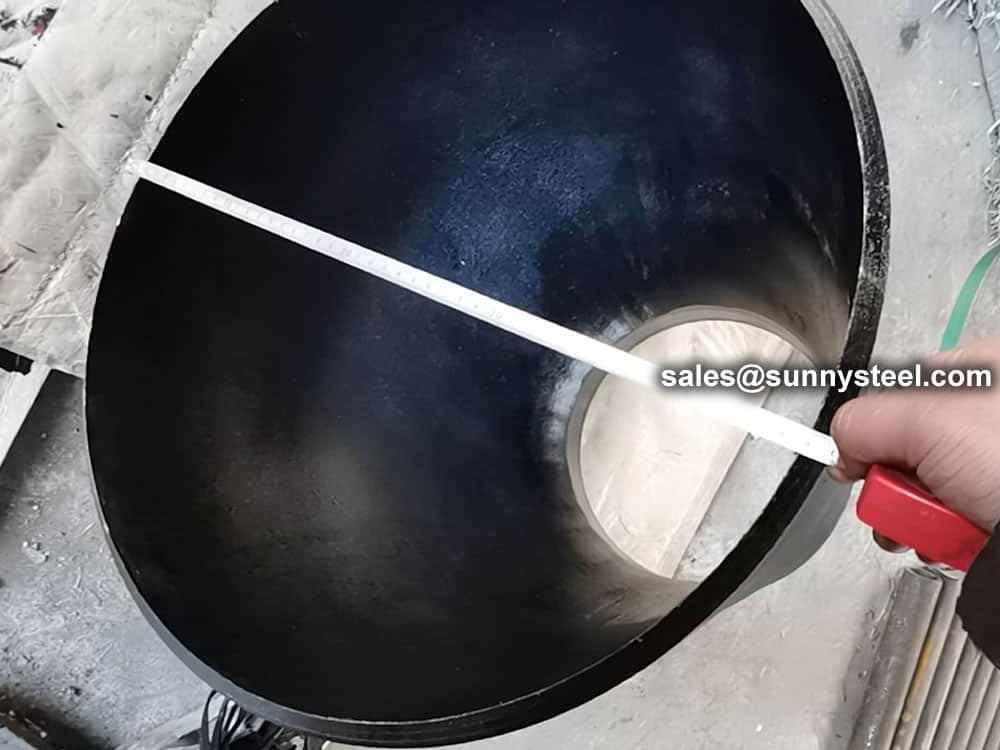
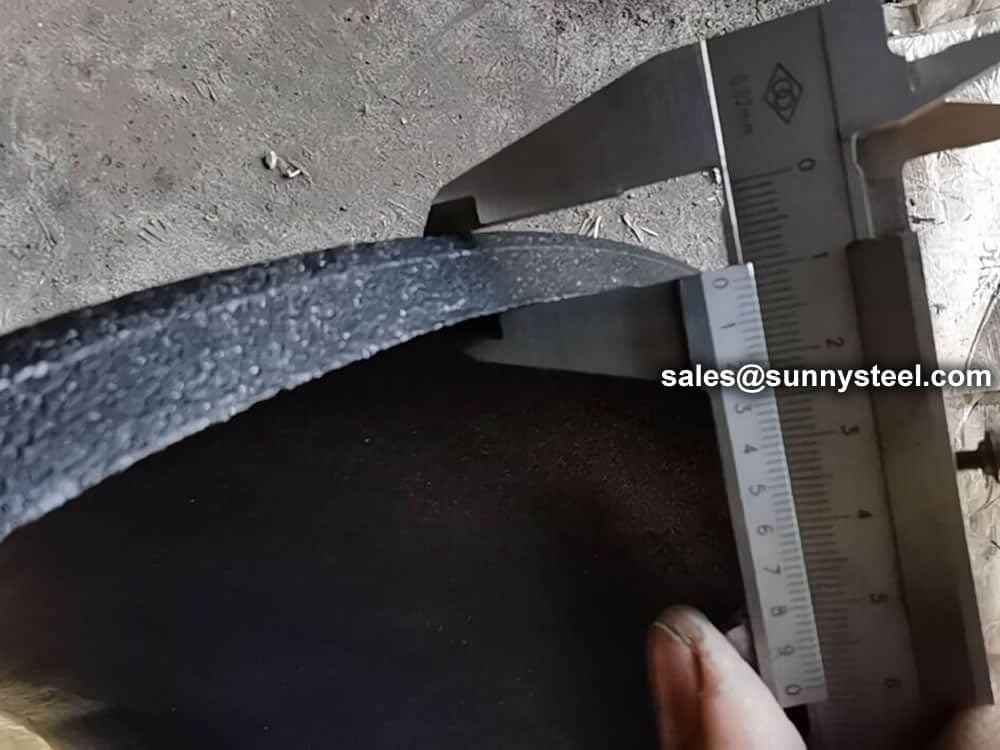
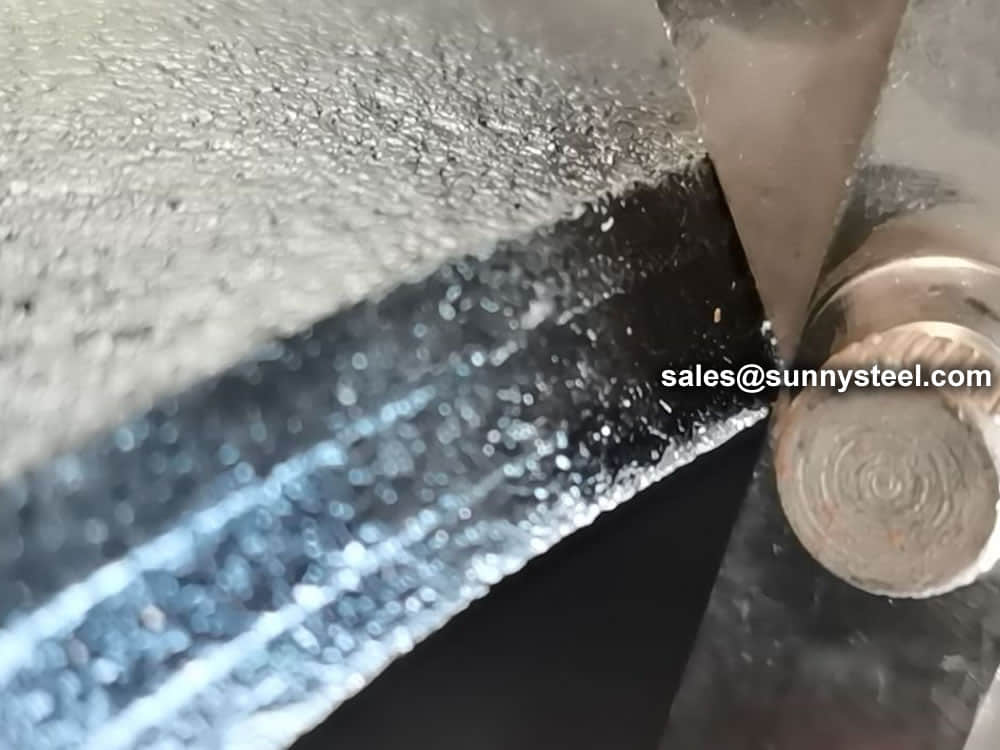
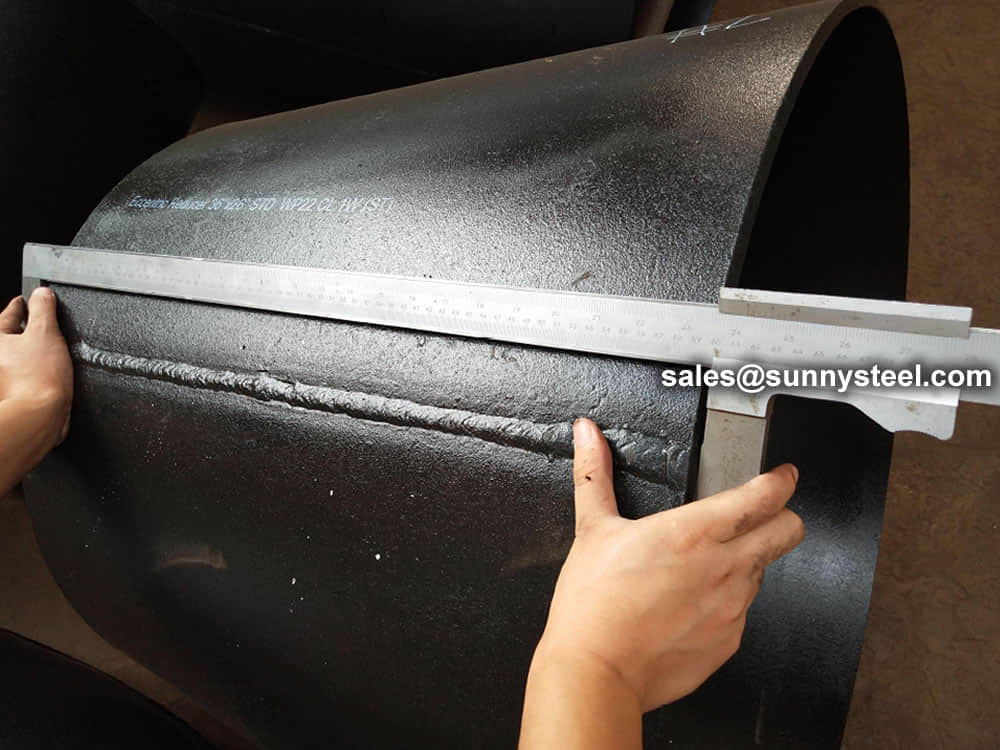
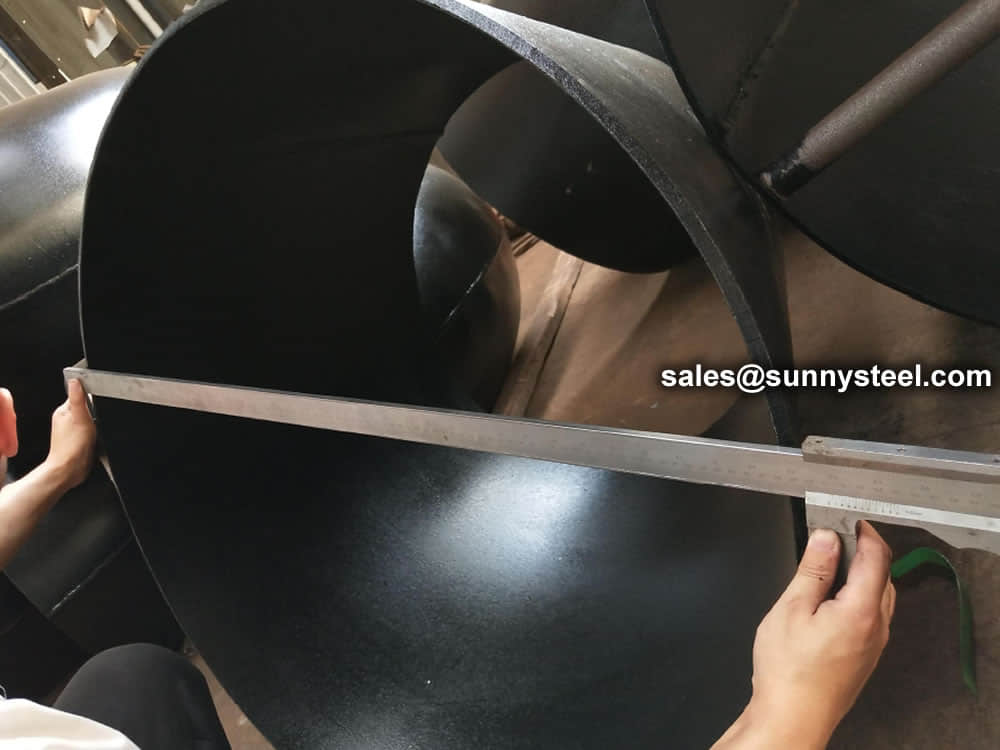
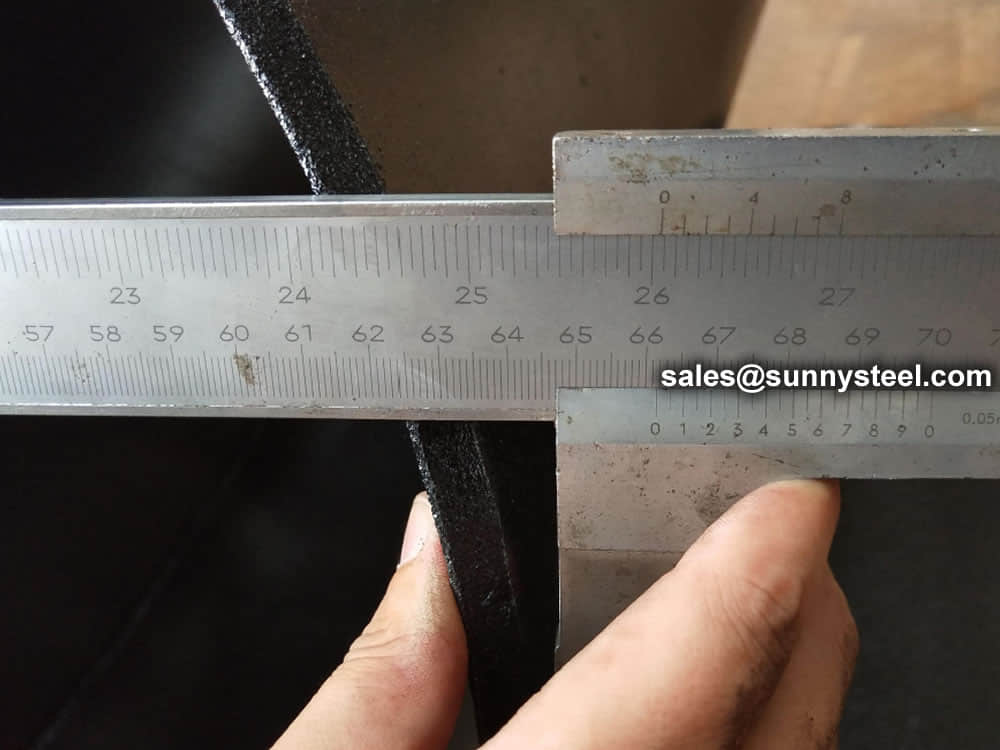
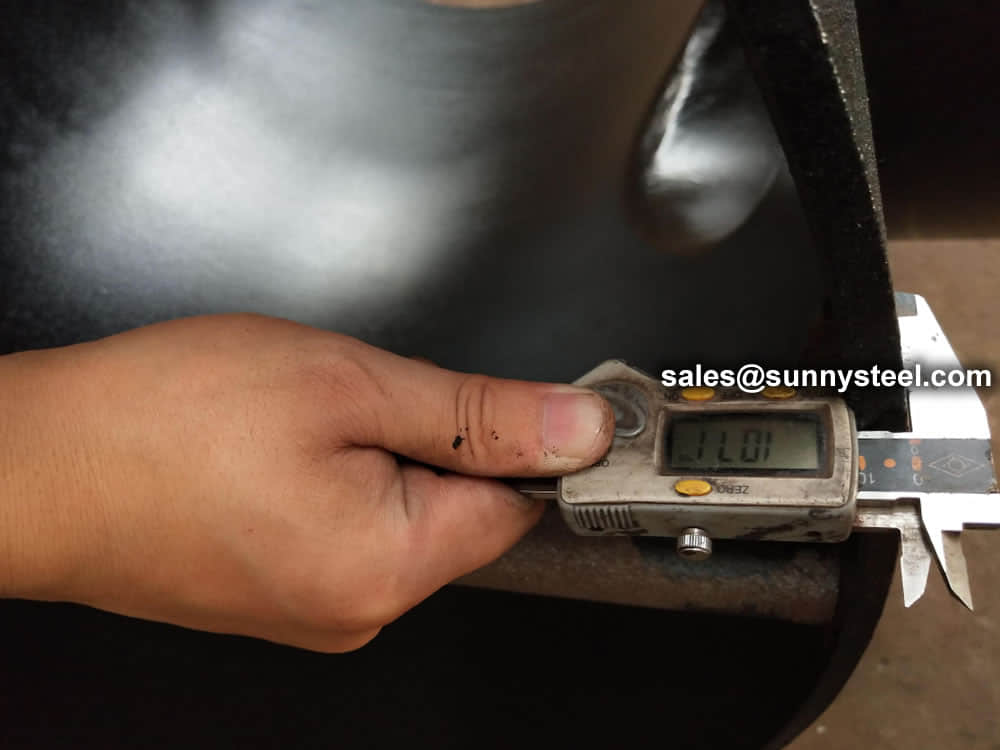
For packing of carbon steel flanges with painting,we would use the bubble wrap to protect the painting.For flanges without painting or oiled with long-term shipment,we would suggest client to use the anti-tarnish paper and plastic bag to prevent the rust.

When you partner with Sunny Steel, you can stop worrying about meeting deadlines thanks to our responsive and timely service. You'll also say goodbye to unnecessary shopping around. Instead, you'll get white glove service from an expert who understands your needs and can get you the materials you need quickly.
